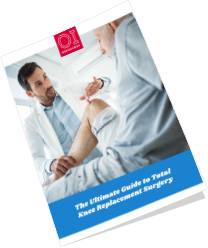If you’re dealing with a painful condition like knee arthritis in both your knees, you may have considered bilateral knee replacement surgery. For many patients, knee replacement provides welcome relief and helps them get back to enjoying life with less pain.
Read on to learn more about bilateral knee replacement surgery, the difference between partial and total replacement and what to expect with surgery and recovery.
What is bilateral knee replacement surgery?
Knee replacement surgery is one of the most effective procedures offered to patients today. It allows someone suffering from a knee condition like arthritis to regain a better quality of life by decreasing knee pain and improving function.
For those suffering from knee pain in both knees, bilateral knee replacement surgery—also called double knee replacement—can be an excellent option to get the treatment done all at once, rather than going through two separate surgeries.
Bilateral knee replacement surgery is considered elective surgery, but most patients are happy after having it done, and many say they wish they’d done it sooner.
Before recommending bilateral knee replacement surgery, a doctor will usually have their patient try non-surgical options for their knee pain first, such as:
- Weight loss
- Anti-inflammatory medications
- Physical therapy
- Steroid injections
- Platelet-rich plasma (PRP) injections or orthobiologic therapies
The main benefit of bilateral knee replacement surgery versus having two separate knee surgeries is convenience. It means less time away from work and one recovery period instead of two (though recovery time will be slightly longer when compared to surgery on one knee).
Who typically gets bilateral knee replacement surgery?
Suppose non-surgical treatments don’t help relieve the pain in your knees. In that case, your doctor may recommend bilateral knee replacement surgery, especially if you have symptoms, including:
- Painful and inflamed knees
- Pain that develops gradually over time or keeps you up at night
- Stiffness in your knee joints that makes it difficult to bend and straighten your knees
- Pain in your knee joints after being active
- Your knees lock up or “stick” during movement
- Your knees creak, click, grind or snap
- Weakness or buckling in your knees
- Instability or limited knee movement
- An X-ray shows bone touching bone somewhere in your knees
The most common cause of chronic knee pain and the reason most people have bilateral knee replacement surgery is arthritis. Although there are many types of arthritis, most knee pain is caused by just three types:
- Osteoarthritis
- Rheumatoid arthritis
- Post-traumatic arthritis
Eligibility for bilateral knee replacement surgery is based on a patient’s pain and level of disability. Most patients who undergo knee replacement surgery are between 50 and 80 years old, but the surgery has been performed successfully on people of all ages, including children.
The best candidates for bilateral knee replacement surgery are physically active and have strength in their muscles, ligaments and tendons around their knees. The healthier someone is, the better they will typically do during surgery and recovery.
Bilateral total knee replacement vs. bilateral partial knee replacement
A total knee replacement surgery involves replacing the diseased portions of a knee joint (the damaged cartilage and part of the bone underneath) with a replacement prosthesis to relieve your pain and make your knee joints work better. A bilateral total knee replacement means both knees have this procedure simultaneously.
With a partial knee replacement, only the diseased portion of the knee is resurfaced rather than replacing the entire knee joint. (In the case of a bilateral partial knee replacement, the procedure would be done on both knees.)
While partial knee replacement surgery is less invasive and reduces the risk of complications, there is a slightly higher risk of needing a repeat surgery within 15 years. A total knee replacement is also more reliable in completely relieving pain for a longer period of time.
You and your orthopedic specialist can decide together if partial or total bilateral knee replacement surgery is right for you.
Realistic expectations for knee replacement
When considering any kind of knee replacement surgery, it’s essential to go into it with realistic expectations about what the procedure can and cannot do.
The majority of people who have bilateral knee replacement surgery will see a dramatic reduction in knee pain and a significant improvement in their ability to do everyday activities. But an important thing to remember is that knee replacement won’t give you superpowers or allow you to do more than you could before you developed arthritis.
Another thing to consider is the appropriate activity level after bilateral knee replacement surgery. Most surgeons advise against high-impact sports like football or hockey or activities like running and jumping, even after you’ve recovered from surgery.
Your doctor will likely recommend you continue to stick to low-impact activities like walking, swimming, golf, dancing or biking.
Bilateral knee replacement surgery risks
The risk of serious complications following bilateral knee replacement surgery is low. (Patients with some pre-existing conditions will have a slightly higher risk than those who don’t.)
Although uncommon, complications can include:
- Infection
- Blood clots
- Scarring
- Continued pain
- Neurovascular injury
Recovery and rehabilitation
Recovery after either full or partial bilateral knee replacement surgery is just as important as the surgery itself. If you don’t follow the instructions of your doctor or therapist, it could negatively impact the outcome of your surgery.
After bilateral knee replacement surgery, you will feel some pain. Your doctor may recommend a prescription-strength medication for short-term pain relief after surgery. Nonsteroidal anti-inflammatory drugs (NSAIDs), acetaminophen and local anesthetics can also help relieve pain.
Your doctor may also prescribe measures to prevent blood clots and reduce swelling, like blood thinners, support hose and compression boots.
Most knee replacement patients can go home within one or two days after surgery. For bilateral knee replacement surgery, the hospital stay can sometimes be a bit longer than it would be after surgery on just one knee.
After your surgery, a physical therapist will work with you and teach you some safe exercises to continue at home. Some patients may be discharged to a rehabilitation facility if they cannot safely return home.
Most knee replacement patients can resume regular (low-impact) activities by about six weeks after surgery. However, bilateral knee replacement recovery may take a bit longer since you’re rehabilitating two knees instead of one.
Schedule an appointment
If you have knee pain and are considering bilateral knee replacement surgery, schedule an appointment with one of our orthopedic specialists to review your options.
If your injury or condition is recent, you can walk right into one of our OrthoIndy Urgent Care locations for immediate care.
For rehabilitation and physical therapy, no referral is required to see one of our physical therapists.

The Ultimate Guide to Knee Pain Relief
Take control of your knee pain, learn about treatment options, and find out if surgery might be able to help you get back to normal.





